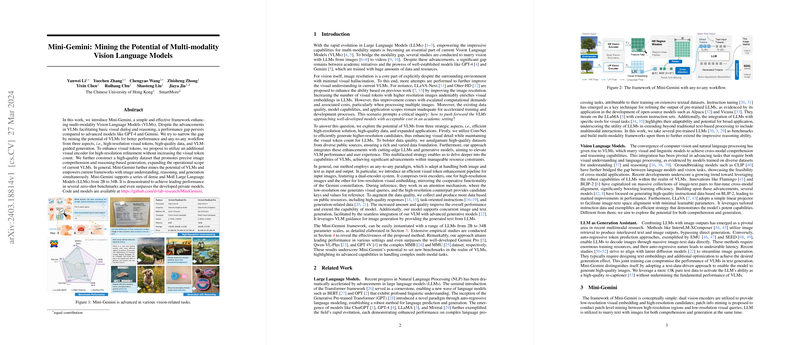Enhancing Vision LLMs with Mini-Gemini: A Dive into Multi-Modality, High-Resolution, and Data Quality
Overview of Mini-Gemini
Mini-Gemini introduces a novel framework aimed at enhancing the capabilities of Vision LLMs (VLMs) by focusing on three key areas: utilization of high-resolution visual tokens, improvement of data quality, and expansion of any-to-any workflow capabilities. By integrating an additional visual encoder, the framework refines high-resolution visual tokens without increasing their count, thereby optimizing computational efficiency. The construction of a high-quality dataset tailored for image comprehension and reasoning-based generation further broadens the operational capabilities of VLMs. Mini-Gemini demonstrates its effectiveness across several dense and Mixture of Experts (MoE) LLMs ranging from 2B to 34B parameters, setting new benchmarks in zero-shot vision tasks.
Technical Insights
Dual Vision Encoders and High-Resolution Image Processing
Mini-Gemini's architecture incorporates dual vision encoders that together enhance the quality and resolution of visual tokens. The low-resolution encoder processes images to create a foundational visual embedding, while the high-resolution encoder provides detailed visual cues. This dual-encoder system, inspired by the Gemini constellation, is designed for efficient processing of high-resolution images without burdening the computational framework with excessive visual tokens.
Enhanced Data Quality
The paper underscores the importance of high-quality data in improving the performance of VLMs. Mini-Gemini leverages a meticulously constructed dataset from various public sources, focusing on image comprehension, text and image generation, and reasoning. The inclusion of high-quality responses and task-oriented instructions significantly contributes to the model's enhanced understanding and generation capabilities.
Expanding VLM Functions
At the heart of Mini-Gemini is an any-to-any inference model that processes both image and text inputs to generate corresponding outputs. This flexibility is achieved through a novel visual token enhancement pipeline and the integration of cutting-edge generative models. The approach not only improves the performance of VLMs in comprehension tasks but also paves the way for innovative applications in image and text generation.
Empirical Validation and Performance
Extensive experiments demonstrate Mini-Gemini's superior performance across a range of zero-shot benchmarks. The framework consistently outperforms existing models, including surpassing developed private models in complex datasets such as MMB and MMU. The empirical results highlight Mini-Gemini's leading capabilities in handling advanced multi-modal tasks, attesting to its potential as a robust tool in the field of VLMs.
Future Directions and Theoretical Implications
The introduction of Mini-Gemini opens new avenues for research in enhancing the performance and applicability of Vision LLMs. The framework's scalable architecture, combined with its focus on high-resolution visual tokens and high-quality data, sets a new standard for future developments in the field. The theoretical exploration of high-resolution image processing and data quality improvements provides valuable insights into the optimization of VLMs. As the community continues to push the boundaries of what's possible with generative AI, Mini-Gemini stands as a significant milestone in the journey towards fully realizing the potential of multi-modality in AI models.
Concluding Remarks
Mini-Gemini represents a significant advancement in the field of Vision LLMs, showcasing the vital role of high-resolution visual processing, quality data, and flexible workflow capabilities. Its exceptional performance across a breadth of benchmarks highlights the effectiveness of its novel approach. As the field moves forward, Mini-Gemini's contributions will undoubtedly serve as a foundation for further innovations, driving the evolution of VLMs towards new heights of capability and application.
